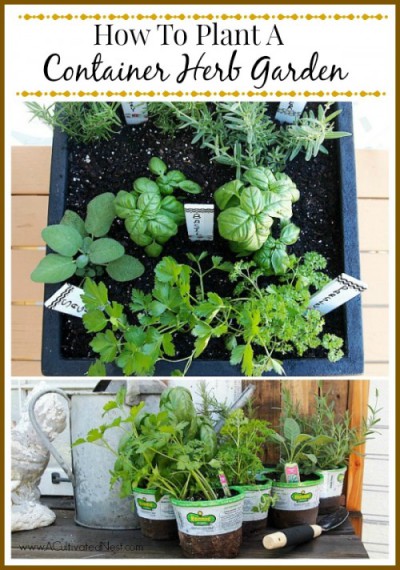A delicious cup of herbal tea can be used to soothe all sorts of everyday ailments like sleeplessness, nausea and digestive issues. Herbal tea also makes a good alternative to regular tea and coffee, especially if you want to reduce your caffeine intake. While buying premade tea mixes or even dried herbs can be pricey, growing your own herbal tea garden is a more budget friendly (and natural) solution! Plus herbs are easy to grow and look beautiful in the garden! Take a look below at how to grow your own herbal tea garden, and see how simple it can be to grow the ingredients you need right in your own backyard!
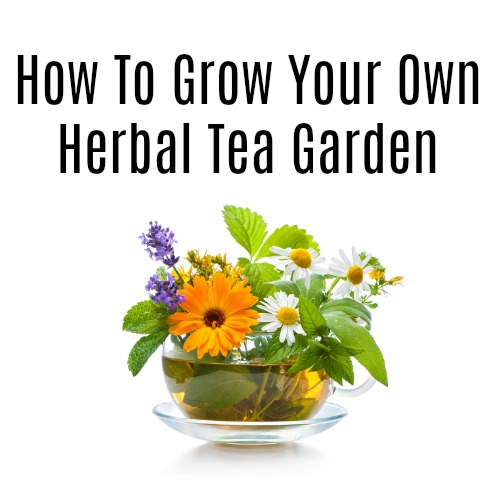
Disclosure: This post may contain affiliate links to Amazon and/or Etsy, which means that I may earn a small commission from some of the links in this post. Please see our Disclosure Page for more information.
It’s not hard to grow your own herbal tea garden! First, let’s look at tea garden plants that are ideal for tea making. Here is a list of herbs perfect for using in your homemade tea recipes, plus a little bit of information on how to grow the specific herbs. At the end are few herbal tea recipes for you to try!
How To Grow Your Own Herbal Tea Garden
Two important things I need to point out.
-
- Do not use chemical pesticides on your herbal tea plants! Whatever you spray them with will wind up in your tea.
- Before adding any herbal remedy to your diet, it’s best to speak with your doctor or do some research to find any possible interactions or risks. You’d be surprised, but some tea ingredients can really interact with some common medications. For example, there are over a dozen medications that can have interactions with black tea.
Herbs to Grow in your Herbal Tea Garden:
1. Chamomile
Chamomile is one of the easiest and most popular tea making herbs to grow in your herbal tea garden. You can use the blooms in your tea making, which gives it a sweet taste and can help with sleeplessness and anxiety.
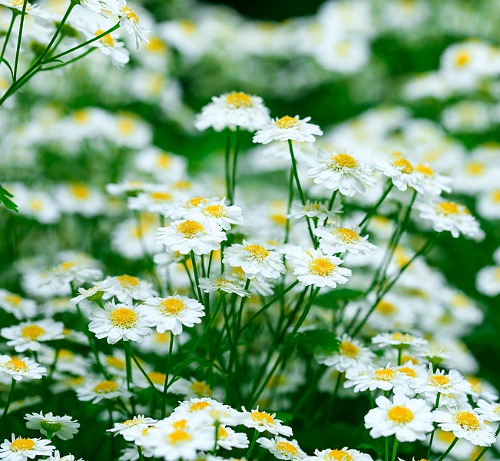
To grow chamomile, buy a ready-to-go seedling from your local gardening center so you can start enjoying blooms sooner. Chamomile prefers well drained soil, moderate sun, and will do well if planted with other herbs such as rosemary.
2. Lavender
Used to help with headaches, anxiety, and sleeplessness, lavender is an easy to grow perennial that will come back in full force each year. It is also one of the more popular and widely used tea making herbs, making it one that I highly recommend you plant when you grow your own herbal tea garden.
To grow lavender, you can plant from seedlings or seeds but seedlings are preferred so you can enjoy a quick harvest. Plant in nutrient rich, well drained soil, spacing seedlings 6 inches apart. You can harvest once you see the small blooms start to open.
3. Mint
Who doesn’t love mint tea? If you have an upset stomach or digestive issues, mint can help. There are sooo many varieties of mint that you can grow! All which will give you similar benefits but have slightly different flavors. Mint is widely used in tea making, and the fact that it spreads so quickly makes it a budget friendly plant that gives you bloom for your buck.

To grow mint, plant from seeds or seedlings. It is advised you plant mint in containers since it can become invasive if planted in beds or gardens. It will do well in shade to moderate sun, and enjoys well drained soil and a good two inches of water per week. Check out this post on reasons you should grow mint . It’s a great herb to have in your garden for lots of reasons!
4. Ginger
Many people think of ginger as a root but it is classified as a spice or herb. Ginger has been relied on for hundreds of years for its medicinal benefits. If you wish to grow ginger, you will find that it can help with muscle aches, cold and flu symptoms, and can even be stored for the winter months (via drying) when these conditions run rampant.
You can grow ginger from an organic rhizome (root) from the grocery store or purchase plants from garden centers. Ginger can be grown in containers or in the ground. Space plants a good 6 inches from each other and make sure they enjoy moist soil that drains well. Ginger will do best in full sun, but can survive in moderate sun as well.
5. Stevia
You may have heard about stevia and how many people are using it in place of sugar. It is naturally sweet and so it can be used to naturally sweeten your tea mixtures. While stevia doesn’t have medicinal properties that we know of, it can help you eliminate sugar from your tea.
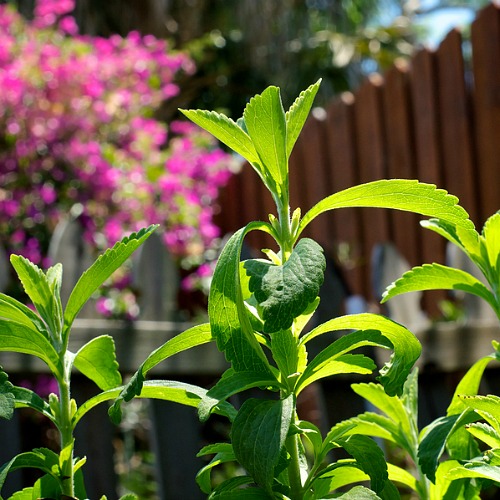
Stevia does well when planted as a seedling. It thrives in full sun but will survive in moderate sun as long as the soil drains well and it gets a good 3 inches of direct watering per week. Mulch can help keep its roots cool and encourage growth.
6. Rosemary
Rosemary is often thought of as a savory herb, but it does work well in your tea mixtures and should be added to your tea garden. It can help with adding antioxidants to your diet, keeping your immune system strong, and keeping your body feeling young!
Rosemary can be planted from seed or seedlings and can start to be harvested in small batches as soon as you have foliage. It prefers part and full sun, with plants spaced at least 6 inches apart. Plant in a flower bed so you can enjoy your rosemary for years to come.
7. Lemongrass
Lemongrass can be used to make tea as well as used in various other recipes (especially Asian cuisines). Instead of using leaves like for most herbal teas, you use the stalks of the lemongrass plant to make tea.
Plant lemongrass as a seedling in full sun. Lemongrass forms a tall, grassy clump 3 to 5 feet tall almost like a ornamental grass (so be sure to give it plenty of space). It also does well in containers.
8. Lemon Verbena
If you suffer from stiff joints and overall body aches and pains, lemon verbena can help. It can be a nice addition to your herbal tea garden, and will offer the area lots of sweet smells as well. Easy to grow, it pairs well with other herbs for the perfect tea mix.
To grow lemon verbena, you may have to plant from seed since the seedlings can be hard to find at most gardening centers. It does well when planted in containers or beds, likes well drained soil, and prefers moderate to full sun.
9. Echinacea.
Echinacea (purple coneflower) is a beautiful addition to your flower garden but it is also classified as a herb. The buds of echinacea can be used to help fight off colds and flu and can also be used to help boost the immune system. So it’s an attractive herb that doesn’t just add beauty to your tea garden, but Echincea tea can offer health support as well. Echinacea should not be used by pregnant women, nursing mothers, or young children.
You can find echinacea seedlings for sale in most areas, but if not, try planting from seed. You can harvest as soon as you see the blooms. It does prefer full sun, protected roots (mulch can help), as well as a boost of liquid plant food every 6 weeks.
10. Rose hips.
A rose hip is the fruit of the rose plant and can be used in tea making. They offer a nice addition of vitamin C to your mixtures which helps reduce inflammation in the body. You can choose from all sorts of roses, giving you lots of choices with colors and shapes in your tea garden.
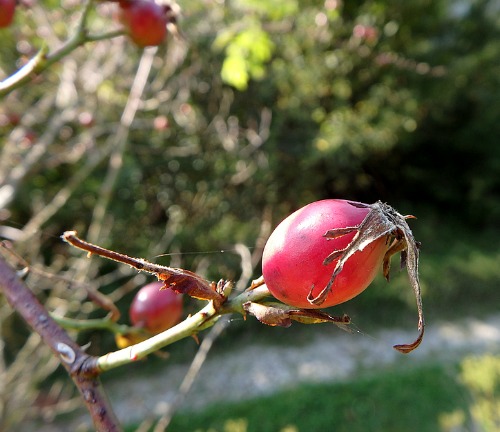
You can harvest rose hips as soon as they are evident on the plant. Caring for roses can be a bit tricky, as they are particular about soil types and do enjoy full sun only. Each plant will differ in care, so it is always smart to consult the individual planting directions. Just be sure you’re using hips from a plant that has not been sprayed with pesticide. Here are some organic rose hips in case you don’t grow roses.
If you’d like to read more about growing your own herbal tea garden, you’ll love this book I found for you on Amazon. It explains “how to grow a large variety of plants in your own garden, on a balcony or even on a windowsill could become your tea cupboard. It shows you how to grow your tea from seeds, cuttings, or small plants, as well as which parts of the plant are used to make tea.” Plus it has lovely illustrations.
Now that you have an idea of what plants and herbs do well in an herbal tea garden, let’s talk about how to prepare a basic herbal tea mixture. Here is a simple recipe for chamomile tea, which is perfect for trying the next time you need help relaxing!
Herbal Tea Recipes
Chamomile Tea Recipe:
Ingredients:
– 1 cup of water
– 2 tablespoons of chamomile flowers, dried (I love this dehydrator) and crushed
– strainer or tea infuser set
– small saucer
– cup or mug
For most of your tea recipes, you will use your herbs in dried and crushed form. Learning how to properly store your crushed herbs is important to keeping them fresh. Be sure you use an airtight jar or container for best results.
Directions:
1. Heat your 1 cup of water to a boil. You can do this in the microwave if you wish.
2. Place the strainer over a cup or mug.
3. Place the crushed herbs in the strainer.
4. Pour the hot water over the strainer.
5. It is smart to place a saucer over the strainer to keep the steam.
6. Let the mixture steep for 20-30 minutes. The longer you let it steep, the stronger it will be.
7. Remove the saucer and strain as needed.
You can then sweeten the tea if you wish, adding natural honey or even some sugar and cream. Remember that stevia is also a natural way to sweeten your tea!
Now, just allow the tea to cool to a comfortable temperature and enjoy!
More Tea Recipes
Peppermint Tea Recipe @ Natural Green Mom
Lavender Mint Tea @ Taste of Home
Rosemary Lemon Tea @ Skinny Ms
Ginger Tea @ A Pretty Life In The Suburbs
Have you ever made tea from something you grew?
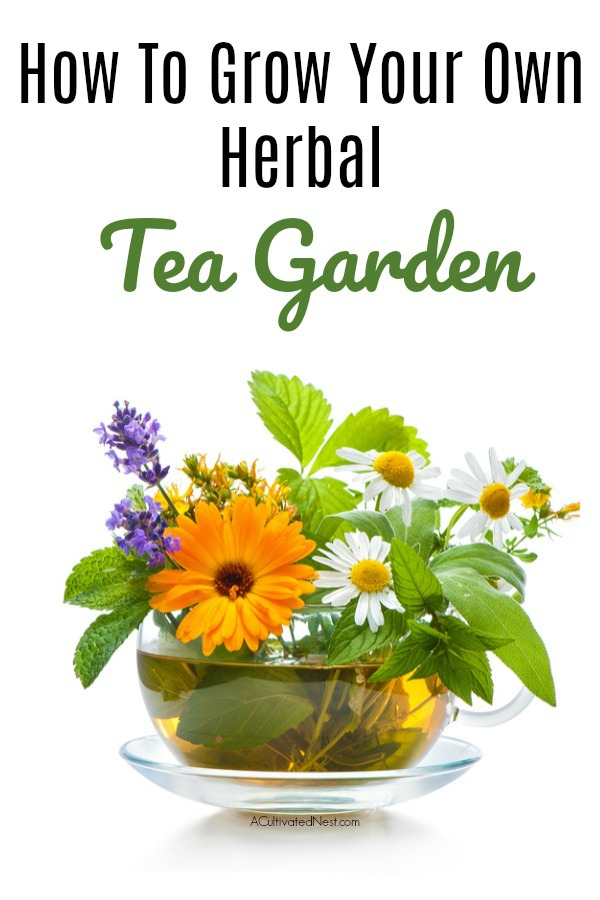
You might also like: How To Plant A Container Herb Garden
